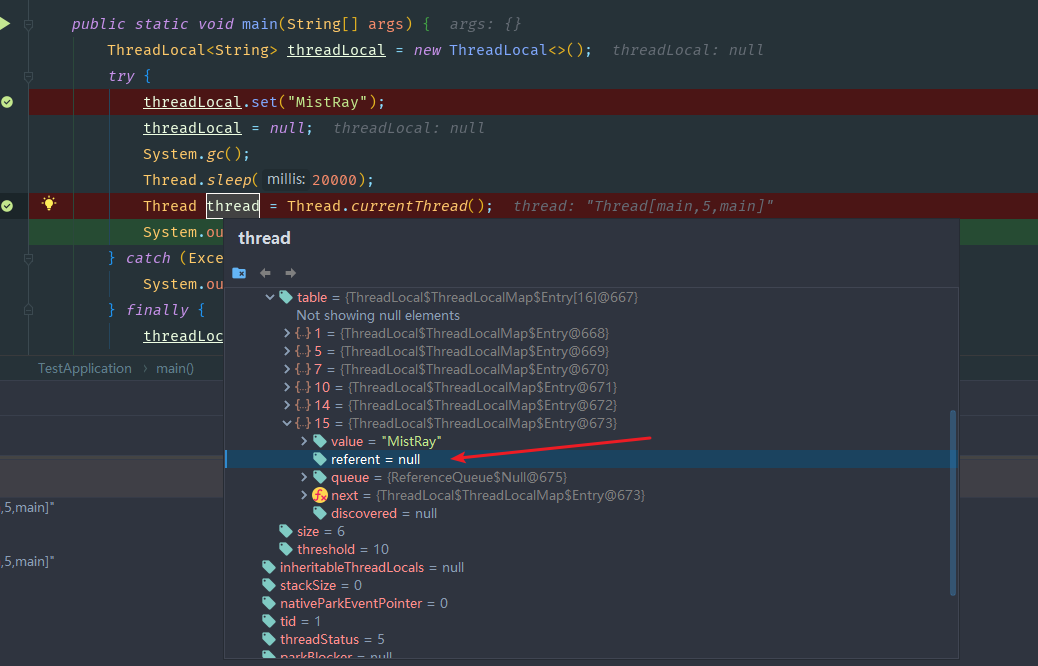前言
标题所述的问题来源于我朋友的某次面试。我朋友具体是怎么回答的我现在已经忘记了,但这个问题勾起了我的兴趣,所以就有了这篇文章。
ThreadLocal
This class provides thread-local variables. These variables differ from their normal counterparts in that each thread that accesses one (via its {@code get} or {@code set} method) has its own, independently initialized copy of the variable.
上面这段文字来自于ThreadLocal注释的开头。意思是,此类提供线程局部变量。这些变量与正常变量不同,因为每个访问一个线程(通过其{@code get}或{@code set}方法)的线程都有其自己的独立初始化的变量副本。 简单点说,它是一个数据结构,有点像HashMap,可以保存”key : value”键值对,但是一个ThreadLocal只能保存一个,并且各个线程的数据互不干扰。
get&set
现在让我们来看下get和set方法的源码
/**
* Returns the value in the current thread's copy of this
* thread-local variable. If the variable has no value for the
* current thread, it is first initialized to the value returned
* by an invocation of the {@link #initialValue} method.
*
* @return the current thread's value of this thread-local
*/
public T get() {
// 获取到了当前的线程
Thread t = Thread.currentThread();
// 从当前线程中获取到了ThreadLocalMap
ThreadLocalMap map = getMap(t);
if (map != null) {
ThreadLocalMap.Entry e = map.getEntry(this);
if (e != null) {
@SuppressWarnings("unchecked")
T result = (T)e.value;
return result;
}
}
return setInitialValue();
}
/**
* Sets the current thread's copy of this thread-local variable
* to the specified value. Most subclasses will have no need to
* override this method, relying solely on the {@link #initialValue}
* method to set the values of thread-locals.
*
* @param value the value to be stored in the current thread's copy of
* this thread-local.
*/
public void set(T value) {
Thread t = Thread.currentThread();
// 从当前线程中获取到ThreadLocalMap
ThreadLocalMap map = getMap(t);
if (map != null)
map.set(this, value);
else
createMap(t, value);
}
/**
* Get the map associated with a ThreadLocal. Overridden in
* InheritableThreadLocal.
*
* @param t the current thread
* @return the map
*/
ThreadLocalMap getMap(Thread t) {
return t.threadLocals;
}
可以发现无论是get还是set方法,操作的都是一个叫ThreadLocalMap的东西。那就让我们来看下这个ThreadLocalMap到底是什么。
ThreadLocalMap
ThreadLocalMap是ThreadLocal中的一个静态内部类,从名字就可以看出ThreadLocalMap是一个Map,但ThreadLocalMap并没有实现Map接口。
ThreadLocalMap中也是初始化一个大小16的Entry数组,Entry对象用来保存每一个key-value键值对,不过这里的key永远都是ThreadLocal对象。通过ThreadLocal对象的set方法,结果把ThreadLocal对象自己当做key,放进了ThreadLocalMap中。
ThreadLocalMap的构造函数
/**
* Construct a new map initially containing (firstKey, firstValue).
* ThreadLocalMaps are constructed lazily, so we only create
* one when we have at least one entry to put in it.
*/
ThreadLocalMap(ThreadLocal<?> firstKey, Object firstValue) {
// 和HashMap相同,内部是一个Entry数组,默认初始化长度为16
table = new Entry[INITIAL_CAPACITY];
// 算出ThreadLocal在数组里面的所在位置
int i = firstKey.threadLocalHashCode & (INITIAL_CAPACITY - 1);
// 把K,V组成的Entry扔到数组里
table[i] = new Entry(firstKey, firstValue);
size = 1;
// 设置扩容的阈值
setThreshold(INITIAL_CAPACITY);
}
/**
* Set the resize threshold to maintain at worst a 2/3 load factor.
*/
private void setThreshold(int len) {
threshold = len * 2 / 3;
}
hash冲突
没有链表结构,那发生hash冲突了怎么办?
先看看ThreadLocalMap中插入一个key-value的实现
private void set(ThreadLocal<?> key, Object value) {
Entry[] tab = table;
int len = tab.length;
int i = key.threadLocalHashCode & (len-1);
for (Entry e = tab[i];
e != null;
e = tab[i = nextIndex(i, len)]) {
ThreadLocal<?> k = e.get();
if (k == key) {
e.value = value;
return;
}
if (k == null) {
replaceStaleEntry(key, value, i);
return;
}
}
tab[i] = new Entry(key, value);
int sz = ++size;
if (!cleanSomeSlots(i, sz) && sz >= threshold)
rehash();
}
每个ThreadLocal对象都有一个hash值threadLocalHashCode,每初始化一个ThreadLocal对象,hash值就增加一个固定的大小0x61c88647。
在插入过程中,根据ThreadLocal对象的hash值,定位到table中的位置i,过程如下:
1、如果当前位置是空的,那么正好,就初始化一个Entry对象放在位置i上;
2、不巧,位置i已经有Entry对象了,如果这个Entry对象的key正好是即将设置的key,那么重新设置Entry中的value;
3、很不巧,位置i的Entry对象,和即将设置的key没关系,那么只能找下一个空位置;
这样的话,在get的时候,也会根据ThreadLocal对象的hash值,定位到table中的位置,然后判断该位置Entry对象中的key是否和get的key一致,如果不一致,就判断下一个位置
可以发现,set和get如果冲突严重的话,效率很低,因为ThreadLocalMap是Thread的一个属性,所以即使在自己的代码中控制了设置的元素个数,但还是不能控制其它代码的行为。
ThreadLocal会导致内存泄露?
空口无凭,这里我写了一个内存泄露的例子
public static void main(String[] args) {
ThreadLocal<String> threadLocal = new ThreadLocal<>();
try {
threadLocal.set("MistRay");
// 消除ThreadLocal的强引用
threadLocal = null;
System.gc();
Thread.sleep(20000);
Thread thread = Thread.currentThread();
System.out.println(thread);
} catch (Exception e) {
System.out.println(1111);
} finally {
threadLocal.remove();
}
}

referent为null,可以看出table里的元素就是ThreadLocalMap中的Entry。
/**
* The entries in this hash map extend WeakReference, using
* its main ref field as the key (which is always a
* ThreadLocal object). Note that null keys (i.e. entry.get()
* == null) mean that the key is no longer referenced, so the
* entry can be expunged from table. Such entries are referred to
* as "stale entries" in the code that follows.
*/
static class Entry extends WeakReference<ThreadLocal<?>> {
/** The value associated with this ThreadLocal. */
Object value;
Entry(ThreadLocal<?> k, Object v) {
super(k);
value = v;
}
}
从Entry中可以看出一些端倪,Entry的父类是WeakReference,也就是弱引用,referent是WeakReference构造函数的参数。 而这里将ThreadLocal作为弱引用的对象,而弱引用的对象只要发生GC就会被回收。(以后会专门写一篇文章来介绍Java中的几种引用)
所以,在唯一的强引用被我主动消除后,这里的弱引用无法支撑ThreadLocal不被GC回收,而Entry的value,只要线程不结束, 就会有一个引用链即:Thread->ThreadLocalMap->Entry->value,所以如果不做处理,value就会一直留存在内存中。
想复现内存泄露必须满足以下两个条件:
- 线程的生命周期很长,且重复利用(例如线程池中的线程)
- 没有调用ThreadLocal的remove函数
正确的使用姿势是这样的
ThreadLocal<String> threadLocal = new ThreadLocal();
try {
threadLocal.set("MistRay");
} finally {
threadLocal.remove();
}
总结
ThreadLocal如果使用不当真的会内存泄露。但只要掌握了正确的姿势,就完全不用担心泄露啦~
Reference
Java面试必问,ThreadLocal终极篇
深入分析 ThreadLocal
ThreadLocal就是这么简单
ThreadLocal-面试必问深度解析
ThreadLocal内存泄漏真因探究
Java中的四种引用类型(强、软、弱、虚)
转载
本文遵循 CC 4.0 by-sa 版权协议,转载请附上原文出处链接和本声明。